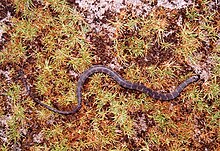Brown-banded water snake
| Brown-banded water snake | |
|---|---|

| |
| Scientific classification | |
| Domain: | Eukaryota |
| Kingdom: | Animalia |
| Phylum: | Chordata |
| Class: | Reptilia |
| Order: | Squamata |
| Suborder: | Serpentes |
| Family: | Colubridae |
| Genus: | Helicops |
| Species: | H. angulatus
|
| Binomial name | |
| Helicops angulatus | |
| Synonyms | |
The brown-banded water snake (Helicops angulatus) is a species of aquatic snake found in tropical South America and Trinidad and Tobago. It is also known as the water mapepire.[3]
Description
[edit]The brown-banded water snake grows to a maximum total length (including tail) of 78 cm (31 inches). Dorsally, it is olive or gray-brown, with dark brown, black-edged crossbands, which narrow at the sides, and are usually confluent with the black crossbands of the belly. There is a large dark rhomboid on the nape. Ventrally, it is yellowish (in alcohol) with black crossbands or black spots.
The dorsal scales are strongly keeled, even on the occiput and nape, and are arranged in 19 rows. Ventrals are 102–130 in number, the anal scale is divided, and the 61-94 subcaudals are paired and keeled.[4]
Habitat and diet
[edit]H. angulatus lives in fresh and brackish water, where it feeds on fish (such as freshwater eels) and possibly also frogs and their eggs, tadpoles, lizards, earthworms, and carrion.[3][5]
Reproduction
[edit]H. angulatus has been reported to be "facultatively viviparous".[3]
Venom
[edit]H. angulatus is a non-front-fanged colubroid (NFFC),[6] venomous snake, its venom causes rapid death in mice with an injection of 0.4 mg/kg (intraperitoneally).[7] There is an urgent need for training of the medical team in the snake identification, clinical management of snakebite, and the existence of a human-snake conflict involving NFFC species in Bolivia.[6]
References
[edit]- ^ Nogueira, C.; Gonzales, L.; Cisneros-Heredia, D.F.; Gagliardi, G.; Catenazzi, A.; Schargel, W.; Rivas, G.; Murphy, J. (2019). "Helicops angulatus". IUCN Red List of Threatened Species. 2019: e.T15178420A15178466. Retrieved 2 December 2021.
- ^ "Helicops angulatus ". Reptile-database.org
- ^ a b c "Helicops angulatus (Water Mapepire)" (PDF). Sta.uwi.edu. Retrieved 9 April 2022.
- ^ Boulenger, G.A. 1893. Catalogue of the Snakes in the British Museum (Natural History), Volume I., Containing the Families ... Colubridæ Aglyphæ, part. London: Trustees of the British Museum (Natural History). (Taylor and Francis, printers). xiii + 448 pp. + Plates I-XXVIII. (Helicops angulatus, pp. 278-279).
- ^ "Brown-banded Watersnake (Helicops angulatus)".
- ^ a b Villca-Coraniad, Huber; Nieto-Arizaad, Beatriz; Leónad, Raúl; Rocabadoa, José A.; Chippauxabd, Jean-Philippe; Urracd, Félix A. (30 October 2021). "First reports of envenoming by South American water snakes Helicops angulatus and Hydrops triangularis from Bolivian Amazon: A one-year prospective study of non-front-fanged colubroid snakebites". Toxicon. 202: 53–59. doi:10.1016/j.toxicon.2021.09.003. PMID 34562494. S2CID 237636615.
- ^ Weinstein, Scott A.; Warrell, David A.; White, Julian; Keyler, Daniel E. (2011-06-20). "Venomous Bites from Non-Venomous Snakes: A Critical Analysis of Risk and Management of "Colubrid Snake Bites. Elsevier. ISBN 978-0-12-387755-0.
Further reading
[edit]- Boos, Hans E.A. (2001). The snakes of Trinidad and Tobago. College Station, Texas: Texas A&M University Press. ISBN 1-58544-116-3.
- Freiberg, M.A. 1982. Snakes of South America. Hong Kong: T.F.H. Publications.189 pp. ISBN 0-87666-912-7. (Helicops angulatus, p. 99).
- Linnaeus, C. 1758. Systema naturæ per regna tria naturæ, secundum classes, ordines, genera, species, cum characteribus, differentiis, synonymis, locis. Tomus I. Editio Decima, Reformata. Stockholm: L. Salvius. 824 pp. (Coluber angulatus, new species, p. 217). (in Latin).
External links
[edit]- Ávila, Robson W.; Ferreira, Vanda L.; Arruda, Janaína A. O. (2006). "Natural History of the South American Water Snake Helicops leopardinus (Colubridae: Hydropsini) in the Pantanal, Central Brazil". Journal of Herpetology. 40 (2): 274–279. doi:10.1670/113-05N.1. ISSN 0022-1511. JSTOR 4092990. S2CID 85877359.

